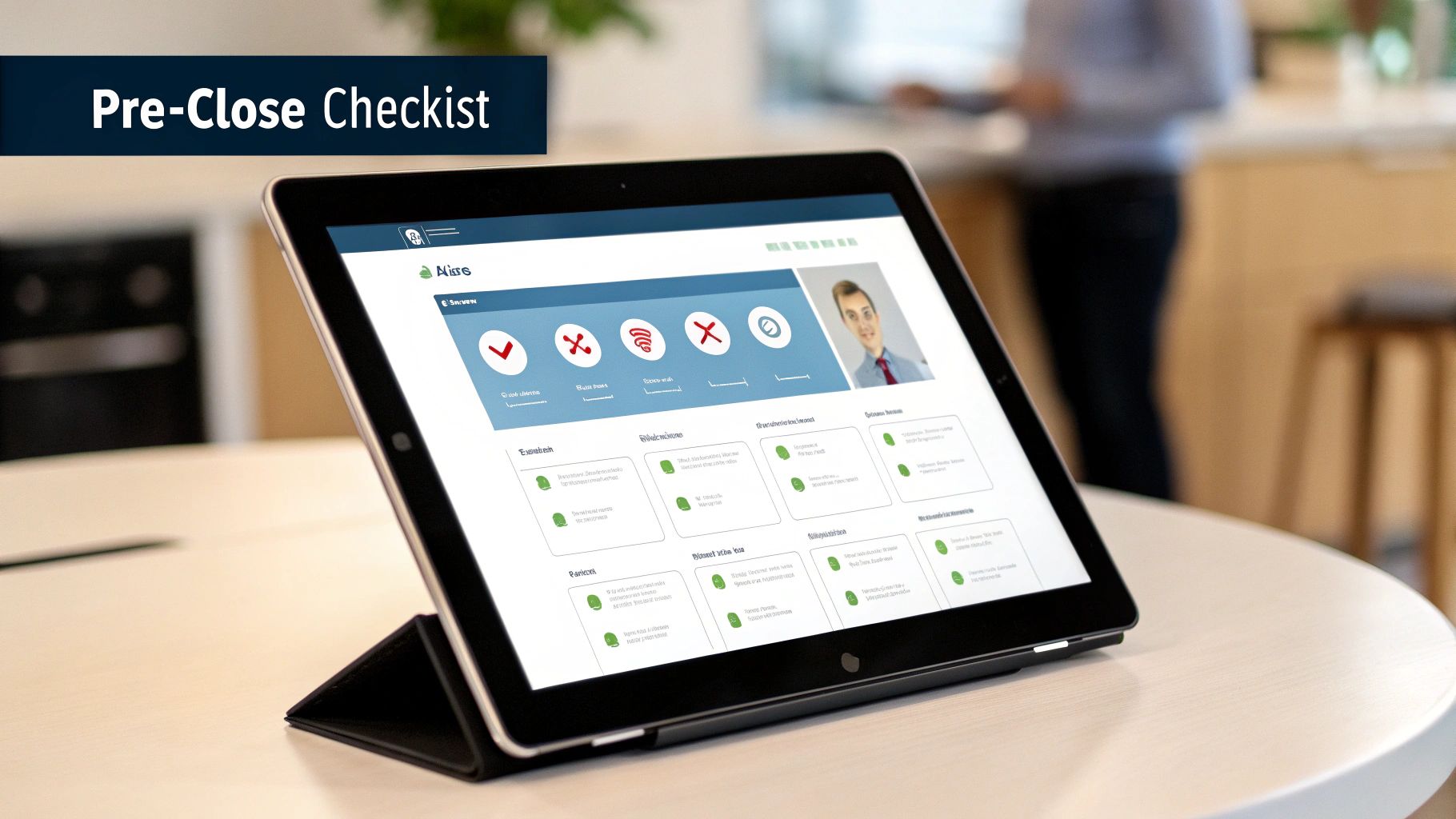The month-end close: for many finance teams, it's a frantic cycle of manual reconciliations, chasing down data, and navigating a labyrinth of spreadsheets. But what if it didn't have to be? Forward-thinking organizations are transforming this high-stress period into a streamlined, automated, and insightful process. This isn't about working harder; it's about working smarter. By adopting modern strategies, you can not only close the books faster but also unlock valuable insights that drive better business decisions.
This guide unpacks eight proven month end close best practices that move beyond the basics. We'll explore actionable steps to build a more efficient, accurate, and strategic financial close process starting today. You'll learn how to implement everything from automated reconciliation and pre-close checklists to a continuous close strategy and centralized documentation.
The core of this transformation lies in leveraging technology to handle repetitive, manual tasks. To truly transform your month-end into a streamlined operation, exploring effective business process automation examples can provide valuable insights into what's possible. Our focus here is to provide a clear roadmap for creating a close process that is not a source of stress but a source of strategic advantage for your business.
1. Automated Reconciliation and Account Matching
Manual reconciliation is one of the most time-consuming and error-prone activities in the month-end close. Implementing automated reconciliation and account matching software is a foundational step in modernizing the close process. This technology uses algorithms to compare general ledger entries against external data sources like bank statements, credit card statements, and subsidiary ledgers, automatically matching transactions and flagging only the exceptions that require human review.

By shifting the team's focus from tedious manual matching to investigating discrepancies, you not only accelerate the close but also enhance its accuracy. Platforms like BlackLine, Kyriba, and Workiva excel at this, handling high-volume accounts with thousands of transactions in a fraction of the time it would take a human. A key challenge, however, is standardizing data from various sources, especially non-standardized bank statement PDFs. Utilizing a tool to convert bank statement PDFs into a structured format like CSV or Excel is often a crucial preparatory step for successful automation.
How to Implement This Practice
Successfully integrating automation into your month-end close best practices requires a strategic, phased approach.
- Start with High-Volume Accounts: Begin with high-transaction, low-complexity accounts, such as primary bank accounts or high-volume clearing accounts. This allows you to demonstrate a quick return on investment and build momentum for the project.
- Establish Clear Matching Rules: Before implementation, define precise one-to-one, many-to-one, and one-to-many matching rules. Set specific tolerance levels for immaterial differences to prevent the system from flagging minor discrepancies.
- Prioritize Data Integrity: Automation is only as good as the data it receives. Ensure your master data (vendor names, customer IDs, chart of accounts) is clean and standardized to prevent matching errors.
- Train for Exception Management: Redirect your team’s training from manual ticking-and-tying to investigating and resolving the exceptions identified by the software. This elevates their role from data entry to data analysis, adding more value to the organization. For a deeper dive into this area, explore these detailed account reconciliation best practices on bankstatementconvertpdf.com.
2. Pre-Close Checklists and Task Automation
A reactive month-end close process, where tasks are addressed as they arise, is a recipe for delays, stress, and errors. Implementing standardized, comprehensive checklists combined with workflow automation is a cornerstone of effective month end close best practices. This approach transforms the close from a chaotic scramble into a predictable, transparent, and manageable process. It involves creating a detailed list of all activities, assigning clear ownership, setting deadlines, and defining dependencies.

By documenting every step, nothing falls through the cracks. When these checklists are integrated into close management platforms like FloQast, Workiva, or OneStream, the process becomes dynamic. Tasks can be automatically assigned and updated based on completion triggers, creating clear accountability and a real-time view of progress for financial leadership. This systematic approach ensures that preparatory tasks are completed before the period ends, smoothing out the workload and preventing last-minute bottlenecks.
How to Implement This Practice
Transitioning to a structured, automated checklist requires more than just listing tasks; it demands a strategic mindset focused on process optimization.
- Map Dependencies and Parallel Workstreams: Don't just list tasks sequentially. Identify which activities can be performed in parallel and which are dependent on others. This allows you to optimize the timeline and allocate resources more effectively.
- Assign Clear Ownership and Escalation Paths: Every single task must have a designated owner and a backup. Define clear escalation paths for when issues arise, so team members know exactly who to contact without losing time.
- Include Preparatory "Pre-Close" Tasks: A successful close begins before month-end. Your checklist should include pre-close activities, such as preliminary accrual calculations or data cleanup, to be completed in the final week of the period.
- Review and Refine Quarterly: The close process is not static. Treat your checklist as a living document. Hold a review session each quarter to identify inefficiencies, update procedures, and incorporate feedback from the team. To get started, you can reference this comprehensive month-end close checklist template.
3. Accrual and Estimate Automation
Manually calculating and posting recurring accruals and complex estimates is a notorious bottleneck in the month-end close. Implementing accrual and estimate automation uses systems to systematically calculate, record, and track these entries based on predefined formulas, historical data, and established methodologies. This approach removes the repetitive, error-prone task of creating manual journal entries for items like payroll, utilities, rent, bad debt provisions, and warranty obligations.
Automating these calculations ensures consistency and reduces the risk of human error or forgotten entries. Dedicated tools like BlackLine's Accrual Management solution or SAP’s Accrual Engine, and even sophisticated Excel templates enhanced with VBA, can handle this process efficiently. These systems automatically generate proposed journal entries based on approved logic, leaving accountants to review and approve rather than create from scratch. This practice is a core component of modernizing the financial close, turning a manual chore into a streamlined, controlled process.
How to Implement This Practice
Integrating this into your month-end close best practices standardizes key judgments and frees up valuable team resources for more analytical tasks.
- Start with Simple, High-Volume Accruals: Begin by automating predictable, rule-based accruals such as rent, software subscriptions, or simple payroll accruals. These offer a clear and immediate return by eliminating repetitive manual work.
- Document All Formulas and Assumptions: Maintain a central repository that clearly documents the logic, data sources, and assumptions behind every automated calculation. This transparency is crucial for internal reviews, auditor requests, and training.
- Build in Override Capabilities: While automation handles the routine, always include a manual override function. This allows for adjustments to be made for non-standard events or one-time transactions that fall outside the predefined logic.
- Establish Clear Approval Thresholds: Implement a workflow with defined approval thresholds. Low-value, standard accruals might be auto-approved, while larger or more complex estimates (like contingent liabilities) require management review, ensuring proper oversight. You can explore a variety of accounting automation tools on bankstatementconvertpdf.com that facilitate these workflows.
4. Continuous Close/Real-Time Close Strategy
The continuous close, or real-time close, fundamentally reengineers the month-end process by distributing closing activities throughout the entire period. Instead of a frantic crunch in the first few days of a new month, tasks like reconciliations, accrual calculations, and intercompany transactions are performed daily or weekly. This modern approach transforms the close from a single, high-pressure event into a manageable, ongoing business process.
By leveraging automation and integrated ERP systems, this strategy provides a constant pulse on financial health, enabling faster decision-making and reducing the risk of month-end surprises. Companies like Microsoft and Cisco have championed this model, shifting their finance teams from historical record-keepers to proactive business partners. The goal is to make "closing the books" a non-event, where financial statements are essentially ready for review at any point in time.
How to Implement This Practice
Transitioning to a continuous close is a significant undertaking that requires a cultural shift alongside technological investment. This is a key month end close best practice for forward-thinking organizations.
- Start with Key Modules: Begin the transition with a single, high-impact area, such as accounts payable or revenue recognition. Proving the concept in a controlled environment builds confidence and provides valuable lessons before a full-scale rollout.
- Automate Foundational Tasks First: A successful continuous close is built on a foundation of automation. Prioritize automating high-volume reconciliations and data entry tasks before tackling more complex areas like judgmental accruals.
- Invest in Cultural Adoption: This is not just a process change; it’s a mindset change. Invest in training your team to embrace daily responsibilities over batch processing and to develop the analytical skills needed to interpret real-time data.
- Run a Parallel Process: Initially, run the continuous close process in parallel with your traditional month-end close. This allows you to validate the new methodology and ensure accuracy without disrupting statutory reporting requirements until the new system is fully proven.
5. Centralized Documentation and Workpaper Management
A disorganized month-end close often stems from scattered documentation, with critical workpapers, supporting evidence, and calculations living in siloed spreadsheets, email inboxes, or even physical binders. Implementing a centralized, cloud-based repository is a crucial best practice that creates a single source of truth. This system stores, versions, and controls access to all close-related documentation, making the process transparent, auditable, and far more efficient.

This modern approach replaces chaotic, paper-based processes with an organized digital workspace that directly links supporting documents to checklist items and reconciliations. Platforms like FloQast and Workiva, or even well-structured SharePoint sites, provide a clear audit trail, simplify review processes, and eliminate the last-minute scramble to find backup for a journal entry. By centralizing these assets, teams can collaborate more effectively and provide auditors with direct, read-only access, significantly reducing the time and stress associated with audit requests.
How to Implement This Practice
Transitioning to a centralized system requires thoughtful planning to ensure adoption and maximize its benefits as part of your month-end close best practices.
- Establish Clear Documentation Standards: Before migrating, define what constitutes "complete" documentation for each type of task. For enhanced organization, implementing effective technical documentation templates can standardize how information is captured and presented.
- Create a Logical Folder Structure: Design a standardized folder and naming convention that is intuitive and scalable. For example, a structure like
YYYY > MM_Month > GL_Account_Number_Account_Name > Task_Nameensures consistency across all periods. - Implement Role-Based Access: Use permission controls to ensure team members can only access or edit the documents relevant to their roles. This enhances security and prevents accidental changes to finalized workpapers.
- Train the Team on a "One-Stop-Shop" Mentality: Cultivate a culture where the centralized repository is the only accepted place for close documentation. Discourage the use of local drives or personal folders for storing workpapers to maintain data integrity. For a comprehensive overview, explore these top-tier document management software for accountants.
6. Intercompany Reconciliation and Elimination Automation
For multi-entity organizations, intercompany transactions are a notorious source of complexity and delays during the month-end close. Manually tracking, matching, and eliminating these transactions is not just time-consuming; it's a high-risk activity prone to errors that can misstate consolidated financial statements. Intercompany reconciliation and elimination automation tackles this head-on by using dedicated systems to identify, match, and reconcile transactions between entities, then automatically generate the corresponding elimination entries.
This automation transforms a painful manual process into a streamlined, exception-based workflow. Instead of accountants emailing spreadsheets and debating discrepancies, the system flags only the out-of-balance transactions that require investigation. Platforms from vendors like SAP, OneStream, and Anaplan provide specialized modules for this, ensuring that intercompany balances net to zero efficiently and accurately. Implementing this is a critical step in achieving a faster, more reliable close for complex corporate structures.
How to Implement This Practice
Integrating intercompany automation is a significant step toward improving your month end close best practices, requiring careful planning and process standardization.
- Standardize Intercompany Processes: Before automation, establish a single, group-wide policy for recording intercompany transactions. Use standardized transaction codes, require detailed documentation upfront for every entry, and create a central intercompany transaction registry for reference.
- Define Matching Logic and Tolerances: Build precise matching rules within the system to pair up transactions based on amounts, dates, and reference numbers. Set clear materiality thresholds to automatically accept minor discrepancies (e.g., due to currency fluctuations), preventing the system from flagging immaterial items.
- Create Clear Resolution Workflows: Design a formal process for investigating and resolving the exceptions flagged by the system. Define clear ownership and escalation paths so that disagreements between entities are resolved quickly and don't hold up the close.
- Test Extensively Before Go-Live: Thoroughly test the matching logic with historical data from a previous period. This helps identify any gaps in the rules or data inconsistencies before the system is deployed live, ensuring a smoother transition and building trust among the accounting teams.
7. Data Validation and Quality Controls Framework
The accuracy of financial statements is directly tied to the integrity of the underlying data. A robust data validation and quality controls framework establishes systematic procedures to verify data completeness, accuracy, and consistency before the closing process even begins. This proactive approach involves reconciling source systems to the general ledger, validating opening balances, and testing automated data feeds, creating a reliable foundation for all subsequent closing activities.
Implementing this framework shifts the accounting team's role from reactive error correction to proactive data governance. Instead of discovering a significant data discrepancy on day five of the close, these issues are identified and resolved at the source. Tools like Informatica and Talend, or even custom GL reconciliation scripts, can automate many of these checks. This ensures that the data flowing into the general ledger is trustworthy, dramatically reducing last-minute adjustments and the risk of material misstatements.
How to Implement This Practice
Integrating a data quality framework is a critical step in maturing your month end close best practices and requires collaboration across departments.
- Create Data Quality Scorecards: Develop and monitor scorecards for each key source system (e.g., CRM, ERP, payroll). Track metrics like data completeness, timeliness of feeds, and error rates to identify and address systemic issues with system owners.
- Establish Materiality Thresholds: Define clear, documented tolerance levels for data discrepancies. This allows the team to focus on significant variances that could impact financial reporting, rather than spending time on immaterial rounding differences.
- Automate Validation Procedures: Where possible, use scripts or dedicated data quality tools to automate the reconciliation of sub-ledgers and source systems to the general ledger. Automate checks for duplicate entries, invalid account codes, or unusual transaction amounts.
- Document Assumptions and Controls: Maintain a central repository documenting all data validation controls, assumptions made in calculations, and the process for resolving exceptions. This documentation is invaluable for audits, training new staff, and ensuring consistency.
8. Shared Service Centers and Process Standardization
For large, multi-entity organizations, decentralizing the month-end close can lead to inconsistencies, redundant efforts, and higher costs. Establishing a shared service center (SSC) consolidates transactional accounting activities like accounts payable, accounts receivable, and general ledger maintenance into a centralized, specialized hub. This model, whether internal or outsourced, leverages economies of scale to drive efficiency and enforce standardized processes across all business units.
By centralizing these functions, companies can implement uniform controls, technologies, and best practices far more effectively than they could across disparate teams. Global giants like Procter & Gamble and Dell have successfully used SSCs to streamline their financial operations, reducing close times and improving data quality. The core benefit is specialization; teams within the SSC become experts in specific processes, leading to faster execution and fewer errors, which is a cornerstone of effective month end close best practices.
How to Implement This Practice
Transitioning to a shared service model is a significant undertaking that requires careful planning and execution to realize its full potential.
- Standardize the Chart of Accounts First: Before centralizing any processes, ensure all business units are operating from a standardized chart of accounts. This foundational step is critical for seamless data aggregation and consistent reporting from the SSC.
- Establish Clear Service Level Agreements (SLAs): Define clear SLAs and Key Performance Indicators (KPIs) for the SSC. These should cover metrics like closing timelines, reconciliation accuracy, and issue resolution speed to ensure the center is accountable to the business units it serves.
- Map and Optimize Processes: Meticulously map all existing "as-is" processes from each business unit before consolidation. Identify inefficiencies and variations, then design a standardized "to-be" process that incorporates best practices from across the organization.
- Invest in Change Management: Shifting responsibilities to an SSC can be a major cultural change. A robust communication and training plan is essential to manage expectations, secure buy-in from business unit finance teams, and ensure a smooth transition. The goal is to create a collaborative partnership, not a disconnected silo.
8-Point Month-End Close Best Practices Comparison
| Solution | 🔄 Implementation complexity | 💡 Resource requirements | ⚡ Speed / Efficiency | 📊 Expected outcomes | ⭐ Key advantages |
|---|---|---|---|---|---|
| Automated Reconciliation and Account Matching | High — integration + customization | Medium–High: reconciliation software, clean master data, IT & accounting time | ⚡ High — automates 60–80% of manual work | 📊 Faster month-end close, fewer errors, audit trails | ⭐ Improves accuracy, scalability, frees staff |
| Pre-Close Checklists and Task Automation | Medium — process design & workflow setup | Low–Medium: checklist templates, workflow tool, owners | ⚡ Medium — fewer omissions, steadier flow | 📊 Consistent closes, better visibility and accountability | ⭐ Standardization, clearer ownership |
| Accrual and Estimate Automation | Medium — rules, validation and approvals | Medium: templates, historical data, approval workflows | ⚡ High for recurring items — reduces JE creation time | 📊 Consistent accruals, faster close, audit-ready entries | ⭐ Consistency, rollback and traceability |
| Continuous Close / Real-Time Close Strategy | Very high — process, systems & cultural redesign | High: robust real-time systems, training, continuous staffing model | ⚡ Very high — near real-time visibility; minimal period-end work | 📊 Ongoing visibility, faster decisions, early error detection | ⭐ Timeliness and proactive financial control |
| Centralized Documentation & Workpaper Management | Medium — migration and governance required | Medium: cloud repository, templates, user training | ⚡ Medium — faster retrieval and audit support | 📊 Improved audit efficiency, consistent documentation | ⭐ Version control, secure access, collaboration |
| Intercompany Reconciliation & Elimination Automation | High — multi-entity rules and mapping complexity | High: standardized codes, consolidated systems, ongoing tuning | ⚡ High — speeds consolidation and eliminations | 📊 More accurate consolidated statements, fewer manual adjustments | ⭐ Reduces elimination errors, improves consolidation cycle |
| Data Validation & Quality Controls Framework | High — control design and thresholds | Medium–High: validation tools, source owners, monitoring processes | ⚡ Medium — prevents rework though may surface issues early | 📊 Higher data integrity, fewer downstream adjustments | ⭐ Foundation for reliable close and auditability |
| Shared Service Centers & Process Standardization | High — organizational change & standardization | High: staffing model, change management, standardized processes | ⚡ High at scale — throughput and cost efficiency | 📊 20–40% cost savings typical, consistent processes across units | ⭐ Economies of scale, specialized expertise and scalability |
From Tactical Task to Strategic Advantage
Navigating the month-end close process can often feel like a frantic race against the clock, a cyclical exercise in data wrangling and validation. However, as we've explored through these eight critical best practices, the close is not merely an operational necessity; it's a strategic opportunity. By moving beyond traditional, manual methods, your finance function can transform from a reactive reporting center into a proactive, value-driving partner to the entire organization.
The journey from a chaotic, spreadsheet-driven close to a streamlined, automated one is built on a foundation of intentional change. The practices detailed in this article, from automated reconciliation and pre-close checklists to adopting a continuous close mindset and centralizing documentation, are not isolated fixes. They are interconnected components of a modern finance ecosystem. Implementing them systematically creates a powerful flywheel effect, where each improvement builds upon the last, compounding efficiency and accuracy over time.
Key Takeaways for a Modern Close
Mastering these concepts fundamentally shifts your team's capacity and focus. The true value lies not just in closing the books faster, but in what that newfound time allows your team to achieve.
- Accuracy and Compliance: Automation, data validation frameworks, and standardized processes dramatically reduce the risk of human error, ensuring a higher degree of accuracy and a more robust compliance posture.
- Strategic Focus: By eliminating repetitive, low-value tasks like manual matching and data entry, you empower your skilled finance professionals to dedicate their expertise to variance analysis, forecasting, and providing strategic insights that guide business decisions.
- Scalability and Growth: A manual close process is a significant bottleneck to growth. A standardized, automated close is scalable, allowing your finance function to handle increasing transaction volumes and complexity without a proportional increase in headcount or stress.
Your Actionable Next Steps
Embarking on this transformation doesn't require a complete overhaul overnight. The most successful initiatives begin with a targeted approach. Start by conducting a diagnostic of your current close process. Identify the single biggest source of delay or frustration. Is it the intercompany reconciliation process? Or perhaps the time spent manually reviewing and validating data?
Once you have identified your primary bottleneck, select one or two of the month end close best practices discussed here to implement first. For example, you could begin by creating a detailed pre-close checklist or by implementing software to automate your most time-consuming account reconciliations. Celebrate the small wins, gather feedback from your team, and use that momentum to tackle the next area of improvement. The goal is continuous, iterative progress that transforms a high-stress period into a smooth, predictable, and insightful process.
One of the most persistent bottlenecks in any close is dealing with manual data from bank statements. Bank Statement Convert PDF helps you eliminate this friction by instantly converting PDF bank statements into clean, usable Excel files, perfectly formatted for your reconciliation software or ERP system. Stop wasting hours on manual data entry and start your reconciliations faster by visiting Bank Statement Convert PDF.


